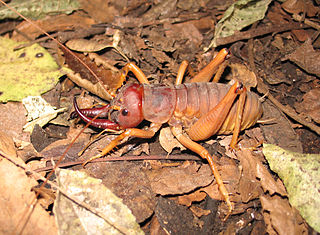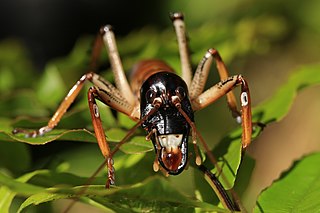
Orthoptera is an order of insects that comprises the grasshoppers, locusts, and crickets, including closely related insects, such as the bush crickets or katydids and wētā. The order is subdivided into two suborders: Caelifera – grasshoppers, locusts, and close relatives; and Ensifera – crickets and close relatives.

Anostostomatidae is a family of insects in the order Orthoptera, widely distributed in the southern hemisphere. It is named Mimnermidae or Henicidae in some taxonomies, and common names include king crickets in Australia and South Africa, and wētā in New Zealand. Prominent members include the Parktown prawn of South Africa, and the giant wētā of New Zealand. The distribution of this family reflects a common ancestry before the fragmenting of Gondwana.

Cooloola is a genus of ensiferan orthopterans known as Cooloola monsters. It is the only genus in the subfamily Cooloolinae and family Cooloolidae of the superfamily Stenopelmatoidea.
Stenopelmatus is one of two genera of large, flightless insects referred to commonly as Jerusalem crickets. They are primarily native to Central America, and one species is known from Ecuador.

Ensifera is a suborder of insects that includes the various types of crickets and their allies including: true crickets, camel crickets, bush crickets or katydids, grigs, weta and Cooloola monsters. This and the suborder Caelifera make up the order Orthoptera. Ensifera is believed to be a more ancient group than Caelifera, with its origins in the Carboniferous period, the split having occurred at the end of the Permian period. Unlike the Caelifera, the Ensifera contain numerous members that are partially carnivorous, feeding on other insects, as well as plants.

The family Stenopelmatidae is composed of large, mostly flightless insects resembling crickets. Two genera: Ammopelmatus and the type genus Stenopelmatus are found in the New World. Oryctopus and Sia are Old World genera, and previously placed in their own subfamilies, but with the addition of new genera, current placement is as five tribes in the single subfamily Stenopelmatinae.

Motuweta is a genus consisting of two species of tusked wētā in the family Anostostomatidae, endemic to New Zealand. The Northland tusked wētā, Anisoura nicobarica, may belong in this group, in which case the genus Motuweta would become a junior synonym of Anisoura.

Hemiandrus is a genus of wētā in the family Anostostomatidae. In New Zealand they are known as ground wētā due to their burrowing lifestyle. Hemiandrus wētā are nocturnal, and reside in these burrows during the day. Ground wētā seal the entrance of their burrow during the day with a soil plug or door so that their burrow is concealed. This genus was originally said to be distributed in Australia and New Zealand, however, with recent molecular genetic methods, this is under debate. Ground wētā adults are smaller than other types of wētā, with the unusual trait of having both long and short ovipositors, depending on the species. The name of this genus is said to come from this trait as hemi- mean half and -andrus means male, as the species where the female has a short ovipositor can sometimes be mistaken for a male. This genus has a diverse diet, depending on the species.

Ammopelmatus is a genus of insects in the family Stenopelmatidae, one of two genera of large, flightless insects referred to commonly as Jerusalem crickets. They are native to southwestern United States and northwestern Mexico.
Ammopelmatus nigrocapitatus, the black-headed Jerusalem cricket, is a species of insect in the family Stenopelmatidae. It is endemic to the United States.

Gryllacrididae are a family of non-jumping insects in the suborder Ensifera occurring worldwide, known commonly as leaf-rolling crickets or raspy crickets. The family historically has been broadly defined to include what are presently several other families, such as Stenopelmatidae and Rhaphidophoridae, now considered separate. As presently defined, the family contains two subfamilies: Gryllacridinae and Hyperbaeninae. They are commonly wingless and nocturnal. In the daytime, most species rest in shelters made from folded leaves sewn with silk. Some species use silk to burrow in sand, earth or wood. Raspy crickets evolved the ability to produce silk independently from other insects, but their silk has many convergent features to silkworm silk, being made of long, repetitive proteins with an extended beta-sheet structure.

Crickets are orthopteran insects which are related to bush crickets, and, more distantly, to grasshoppers. In older literature, such as Imms, "crickets" were placed at the family level, but contemporary authorities including Otte now place them in the superfamily Grylloidea. The word has been used in combination to describe more distantly related taxa in the suborder Ensifera, such as king crickets and mole crickets.

Deinacrida connectens, often referred to as the alpine scree wētā, is one of New Zealand's largest alpine invertebrates and is a member of the Anostostomatidae family. Deinacrida connectens is a flightless nocturnal insect that lives under rocks at high elevation. Mountain populations vary in colour. This species is the most widespread of the eleven species of giant wētā (Deinacrida).

Hemideina thoracica, commonly known as the Auckland tree wētā or tokoriro is a cricket-like insect. It is endemic to New Zealand and is found over most of the North Island, except for the Wellington region and regions 900 metres above sea level. This species is an arboreal, herbivorous generalist however, it is also thought to be polyphagous and is found in all wooded habitats, including forest, scrub and suburban gardens.

Hemideina maori, also known as the mountain stone wētā, is a wētā of the Anostostomatidae family. They are a large, flightless, nocturnal orthopteran endemic to New Zealand. Mountain stone wētā are long lived and are found on many central mountain ranges in New Zealand's South Island.

Tettigoniidea is an infraorder of the order Orthoptera, with six extant families.
Ammopelmatus mescaleroensis, the mescalero Jerusalem cricket, is a species of Jerusalem cricket in the family Stenopelmatidae. It is found in North America.

Mary Morgan-Richards is a New Zealand biologist, and as of 2019 is a full professor at the Massey University.

Wētā is the common name for a group of about 100 insect species in the families Anostostomatidae and Rhaphidophoridae endemic to New Zealand. They are giant flightless crickets, and some are among the heaviest insects in the world. Generally nocturnal, most small species are carnivores and scavengers while the larger species are herbivorous. Wētā are preyed on by introduced mammals, and some species are now critically endangered.

Hemiandrus focalis is a species of ground wētā endemic to New Zealand. This flightless Orthoptera lives in the mountains of the South Island, New Zealand. This species can be distinguished from other ground wētā by their three superior retrolateral spines on their mid tibia and females have relatively long ovipositors. This omnivorous ground wētā species is listed as "not threatened" by the New Zealand Department of Conservation.

















